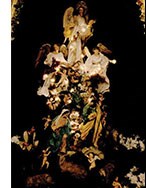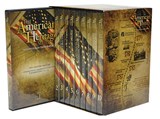David Barton
WallBuilders founder and director
December 2015 – Even though Christmas did not become a national holiday until 1870, it has a centuries old history in America. Interestingly, in colonial America, the southern regions that were more directly linked to High-Church traditions (e.g., Anglicans, Catholics, Episcopalians) celebrated Christmas; but the northern regions especially linked to Low Church traditions (e.g., Congregationalists, Baptists, Quakers) did not. Those Low Church colonists associated the pomp and grandeur of Christmas celebrations directly with the autocratic leaders and monarchs that they so opposed in Europe.
Massachusetts therefore passed an anti-Christmas law in 1659, and it was not until the 1830s and 1840s that Christmas celebrations became accepted in New England (although as late as 1870, a student missing school on Christmas Day in Boston public schools could be punished or expelled). But by the 1880s, Christmas celebrations were finally accepted across the country and began to appear at the White House. For example:
In 1889, the first indoor decorated tree was placed in the White House, and in 1895, electric lights were added.
In 1923, the first National Christmas Tree Lighting Ceremony was held. In 1954 it was named the Pageant of Peace, but in 1969 it became embroiled in a legal controversy over the use of religious symbols. In 1973, the nativity scene that had always been part of the pageant was no longer allowed, but in 1984, it returned.
In 1953, the first White House Christmas card was created by President Dwight (Ike) Eisenhower. (Ike was an artist in his own right and allowed six of his own paintings to be used as Christmas gifts and cards.) President Kennedy’s 1963 Christmas card was the first to include an explicitly religious element, featuring a photo of a nativity scene. And in 2001, the first White House Christmas card to contain a Scripture was chosen by Laura Bush. It quoted Psalm 27: “Thy face, Lord, do I seek. I believe that I shall see the goodness of the Lord in the Land of the Living” – a Scripture she had chosen on September 16 (only 5 days after 9/11), based on a special sermon preached at Camp David.
Christmas was celebrated by our national leaders as a religious holiday, not the secular holiday it has become.
For example, every Christmas Eve, President Teddy Roosevelt and his family would pile into the family sleigh (later the motor car) and travel to a Christmas service at Christ Church in Oyster Bay, New York. Following the pastor’s sermon, Teddy would deliver one of his famous “sermonettes” on the true meaning of Christmas and then close the service with one of his favorite hymns, “Christmas By the Sea.”
President Franklin Roosevelt would set up and decorate a tree on Christmas Eve, gather the family round him, and either read Charles Dickens’ A Christmas Carol or recite it from memory. (The original story is quite different from the modern movies by that name and is well worth the read.) He would also deliver explicitly religious Christmas Eve messages to the nation. For example, in 1944 following D-Day, he said:
Here, at home, we will celebrate this Christmas Day in our traditional American way – because of its deep spiritual meaning to us; because the teachings of Christ are fundamental in our lives; and because we want our youngest generation to grow up knowing the significance of this tradition and the story of the coming of the immortal Prince of Peace and good will. . . . [FDR then prayed a prayer for the troops, and closed with:] We pray that with victory will come a new day of peace on earth in which all the Nations of the earth will join together for all time. That is the spirit of Christmas, the holy day. May that spirit live and grow throughout the world in all the years to come.
In recent years, there has been a relentless push from secularists and progressives to transform Christmas. Schools, government offices, and many commercial stores have replaced Merry Christmas with Happy Holidays to appease critics, not realizing that 93% of Americans celebrate Christmas, and 97% are not bothered by the use of the phrase “Merry Christmas.” Yet far too often, the 3% seem to drive public policy; Americans need to push back.
Gratefully, religious Jews have been some of the strongest advocates for keeping Christmas a religious celebration. For example, Burt Prelutsky, a Jewish columnist for a number of national publications, declares:
I never thought I’d live to see the day that Christmas would become a dirty word. ... How is it, one well might ask, that in a Christian nation this is happening? … Speaking as a member of a minority group – and one of the smaller ones at that – I say it behooves those of us who don’t accept Jesus Christ as our savior to show some gratitude to those who do, and to start respecting the values and traditions of the overwhelming majority of our fellow citizens, just as we keep insisting that they respect ours. Merry Christmas, my friends!
Orthodox Jewish Rabbi Daniel Lapin agrees:
Secular fundamentalism has successfully injected into American culture the notion that the word Christmas is deeply offensive. … Anti-Christianism is unhealthy for all Americans; but I warn my brethren that it will prove particularly destructive for Jews. … Let us all go out of our way to wish our many wonderful Christian friends – a very merry Christmas. Just remember, America’s Bible belt is our safety belt.
So … Merry Christmas! 
The Christmas card that was never mailed
President and Mrs. John F. Kennedy had already settled on the design for their annual Christmas card by the time they left the White House on November 21, 1963, for a campaign swing through Dallas, Texas. The cover of the 4½˝ x 6½˝ card would feature a color photograph of an 18th- century Neapolitan crèche that had been displayed in the East Room each year they had lived at 1600 Pennsylvania Avenue. The message inside would read: “With our wishes for a Blessed Christmas and a Happy New Year.”
century Neapolitan crèche that had been displayed in the East Room each year they had lived at 1600 Pennsylvania Avenue. The message inside would read: “With our wishes for a Blessed Christmas and a Happy New Year.”
According to Smithsonian Magazine, the Kennedys had signed 75 cards and planned to sign the rest when they returned from their holiday travels.
The cards were never mailed. One is kept in the collections of the Smithsonian National Museum of American History.
smithsonianmag.com, 1/14
____________________
 David Barton is founder and president of WallBuilders (Wallbuilders.com), a ministry committed to revealing the truth about Christian faith in the founding and history of the U.S. In The American Heritage 10-DVD series, Barton reveals the forgotten and astonishing story of our nation’s foundation. A six-part sequel traces America’s unique religious, moral, and constitutional heritage. Both collections are available at afastore.net.
David Barton is founder and president of WallBuilders (Wallbuilders.com), a ministry committed to revealing the truth about Christian faith in the founding and history of the U.S. In The American Heritage 10-DVD series, Barton reveals the forgotten and astonishing story of our nation’s foundation. A six-part sequel traces America’s unique religious, moral, and constitutional heritage. Both collections are available at afastore.net.